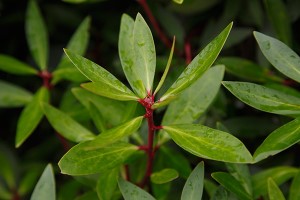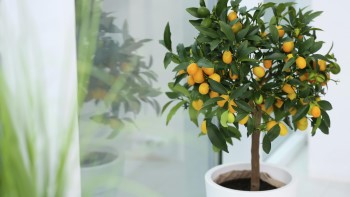- Houseplants
- 3,279
Syngoniums are a genus of evergreen climbing plants native to the tropical forests of Central and South America. These vibrant plants, characterized by large pointed leaves, beautiful stems, and delicate foliage, have become increasingly popular houseplants in recent years.
Their attractiveness and easy-care nature make them ideal for novice gardeners or those without much time or space for a complicated garden. With proper care, syngoniums will provide bright, beautiful greenery for years to come.
If you've decided to bring a syngonium into your home, this guide by Garden Pie will help you on how to grow and care for Syngonium plant.
Table of contents [Show]
- 1 What you need to know about syngonium
- 2 Appearance of syngonium
- 3 Characteristics of syngonium
- 4 Uses for syngonium
- 5 How to grow syngonium ?
- 6 Caring for syngonium
- 7 How often you should water and feed syngonium
- 8 How and when to prune syngonium ?
- 9 Diseases and pests that affect syngonium
- 10 How to Propagate Syngonium ?
What you need to know about syngonium
Syngonium is a genus of tropical, evergreen, low-growing plants from the family Araceae. The genus includes over 40 species of herbaceous vines and shrubs with distinctive, arrow-shaped leaves. Most species are native to the tropical rainforests of Central and South America.
Syngoniums prefer high humidity and temperatures between 65–80°F (18–27°C). They may suffer from plant diseases if grown in too hot or too cold environments. These plants can thrive in bright, indirect light or partial shade and need to be protected from direct sunlight.
When grown indoors, Syngoniums benefit from regular fertilizing during the growing season. It is important to maintain evenly moist soil and to avoid overwatering. It is also beneficial to provide humidity to these plants by misting them daily or using a humidity tray.
Syngoniums can be propagated from either stem cuttings or division. For stem cuttings, simply cut away an juvenile stem with a few leaves and place it in a rooting hormone, such as willow water, and in a pot with moist soil. For division, carefully separate a mature plant into several parts and pot each piece in a separate pot filled with moist soil.
Facts about syngonium includes:
- Name: Syngonium, Arrowhead Vine, Goosefoot, Syngonium Podophyllum.
- Height: From 1-4m Tall & Wide.
- Plant type: An Evergreen Vine.
- Climate: Warm, Frost-Free Outdoors & Suitable for All Indoor Situations.
- Soil: This plant is adaptable to most soil types as long as it is well-drained; for indoor plants, use a premium quality potting mix.
- Position: It will thrive in part shade or filtered light outdoors and a spot with bright, indirect light indoors.
- Flowering and fruiting: When in bloom, it produces cream flowers consisting of a spadix and spathe.
- Feeding: Regularly feed it with a liquid feed from spring to autumn.
- Watering: When you water, make sure that you allow the top of the potting mix to nearly dry out before you water again.
Appearance of syngonium
Syngonium is a genus of beautiful, low maintenance, evergreen, tropical plants belonging to the family Araceae. The genus is native to tropical and subtropical regions of Brazil, Mexico, and the Caribbean.
The Syngonium genus is known for its unique, arrow-shaped foliage that begins in a juvenile state of deeply lobed leaves with creamy white or pink margins. As they mature, the leaves become less lobed and gradually develop into a smooth arrowhead shape. The most common species, Syngonium Podophyllum, features leaflets of a deep, glossy green with white or pink foliage markings.
Depending on the variety, the arrows may be either plain or adorned with striking white, pink, or white-and-green variegation. They may also feature alternate green-and-white marbled leaves. The leaves of younger plants are more likely to exhibit these variegated patterns, and the older the plant is, the more solid green the foliage will become.
They tend to have trailing, slender stems and vines that will require support unless planted in a hanging planter. These plants prefer well-draining soil, indirect light, moderate humidity, and warm temperatures.
Characteristics of syngonium
Syngonium, also known as Arrowhead, African Evergreen, or Goosefoot Plant, is an interesting and easy-care houseplant with many variations of foliage colors and leaf shapes. It is a low-light tolerant plant that can adapt to many different environments. The plant is widely grown for its beautiful foliage, and can be found in many species, including Syngonium podophyllum, Syngonium angustatum, and Syngonium erythrophyllum.
The most distinguishing characteristic of these plants is their arrow-shaped or lancet-shaped leaves, which can range in color from light greenish-grey to dark green and are often variegated. The stems of Syngonium plants are thin, glossy, and can have a purple hue when exposed to brighter light. The plant has a long, trailing habit, making it perfect for displaying in hanging baskets or containers.
It's plant prefer medium to indirect light, which should be provided for 12 to 14 hours every day. The soil should consist of a well-draining mix that is slightly moist. It is important to remember not to let the plant become too wet, as this can lead to root rot.
They are incredibly easy to care for, and just need to be watered regularly and pruned to keep them looking their best. Although they are low-light tolerant, it is recommended to give the Syngonium some supplemental light in order to encourage growth and to maintain its vibrant colors.
Uses for syngonium
As a houseplant, Syngonium's popular for its attractive and air-purifying qualities. Its arrow-shaped leaves and trailing vines also make it an ideal accent piece and source of natural home decor. It also makes a great addition to terrariums or other living arrangements.
In commercial settings, Syngonium is used to add life to office buildings, restaurants, and retail outlets. Its striking foliage often enhances the atmosphere of such establishments and provides a beautiful display for customers and visitors.
It's plants are also famous for their air-purifying capabilities. The genus is known to be one of the best houseplants for filtering out airborne toxins and chemical pollutants that can harm indoor air quality.
They can also be used in traditional folk medicine. For instance, various indigenous communities believe that the root extract can be used to cure scorpion and snake venom. Additionally, the leaves and stem can be brewed into a herbal tea via decoction that offers a range of health benefits.
How to grow syngonium ?
Here are a few tips on how to grow syngonium:
1. Choose a location. Syngonium prefer bright, but indirect sunlight. Try to find a spot near a window that is not too hot, such as the North side of the room.
2. Water your Syngonium once a week or whenever the soil has dried out. Keep the soil on the dryer side since the plant does better when it is not constantly wet.
3. Fertilize your plant once a month with a houseplant fertilizer.
4. Prune dead or discolored leaves periodically to keep it looking neat.
5. Propagate Syngonium by cutting the stem below the leaf nodes and placing in moist soil.
6. Repot your Syngonium every two to three years to give it space to keep growing. Use a well-drained potting mix and move to the next size pot once the roots are taking up too much of the current pot.
7. If you think your Syngonium has contracted a disease or fungus, quarantine it away from other plants, and treat with a fungicide or insecticide.
Caring for syngonium
Syngonium plants need moderate to bright indirect light, but direct light should be avoided. They should be kept away from heat and cold drafts. The soil should always be kept moist, but never soggy, and do well with a water once every week or two. They can tolerate dry conditions, but more frequent watering will result in faster growth. Keeping the soil too wet can cause root rot and other fungal diseases.
They should be fed once a month with a balanced fertilizer such as 10-10-10. If the plant becomes brown or scorched looking, it is probably suffering from too much direct sun, usually found in south-facing windows. They like even, temperate humidity. To increase humidity, regular misting may be done. Keep in mind that powdery mildew or other fungal diseases can occur if the air in the room is too moist.
When repotting, never bury the stem too deep in the soil as this can cause the plant to rot. Pruning of the plant should be done when necessary to maintain a neat shape and reorganize the plants climbing structures. This includes removing any brown tips or snapping off the bottoms of long vines. All them care should be taken not to damage the remaining healthy foliage.
How often you should water and feed syngonium
Syngonium plants require moderate amounts of water and feeding in order for them to remain healthy and vibrant.
Watering frequency depends mostly on the climate conditions that the plant is kept in. During its active growth period, from spring to early fall, the plant should receive water two times a week, making sure that the soil is not allowed to completely dry out between waterings. In winter, when the plant is less active, waterings can be reduced to once a week.
When it comes to feeding, Syngonium plants should be fertilized every two weeks during the active growing season. For best results, use a balanced water-soluble fertilizer mixed at half strength. Alternatively, slow release pellets or granular organic fertilizers can be used as well. Make sure to discontinue fertilizer applications in the winter months when the plant is dormant.
How and when to prune syngonium ?
Syngonium plants are easy to care for and require minimal pruning. Pruning should be done when the plant gets leggy or has too many shoots or is outgrowing its space. Pruning also helps control the size and shape of the plant.
They should be pruned at least once a year to keep them healthy and growing. The best time to prune Syngonium plants is in the spring or early summer when the plants are actively growing. Pruning during the dormant season can shock the plant and reduce its health.
When pruning, the pruners should be sharp so as not to damage the stems. Cut back any growth that is leggy or too long, or any stems that are growing inwards towards the center of the plant. Do not prune any stem that is longer than half the height of the plant, as this could damage new growth and delay flowering. Pruning should also focus on removing any dead or dying leaves.
Diseases and pests that affect syngonium
Syngonium plants can experience a variety of diseases and pests, just like any other houseplant.
Some of the most common diseases and pests that can affect syngonium plants are bacterial and fungal diseases and common insect pests.
Bacterial Diseases
Bacterial diseases can quickly kill syngonium plants, and are usually caused by over-watering or poor drainage. Symptoms of bacterial diseases in syngonium plants include wilting foliage, dark brown or black spots on the leaves, and yellowing and dropping of foliage.
To combat bacterial diseases it is important to make sure the plants are not being over-watered, and to remove any wilting or diseased foliage as soon as it is spotted.
Fungal Diseases
Fungal diseases can also be a problem for syngonium plants, and are often caused by poor drainage or high moisture levels. Symptoms of fungal diseases in syngonium plants include dark spots on the foliage, wilting and yellowing of the foliage, and the death of the plant.
To combat fungal diseases it is important to make sure the plant is not over-watered, and to provide adequate drainage.
Common Insect Pests
Common insect pests can also cause problems for syngonium plants. The most common insect pests that can affect syngonium plants are aphids, mealybugs, spider mites, and scale insects. Symptoms of insect pests in syngonium plants include yellowing and curling of the foliage, spots on the leaves, and sticky residue on the stems and leaves.
To combat insect pests on syngonium plants, it is important to inspect the plants regularly for signs of infestation, and to treat the plants with an appropriate insecticidal soap or neem oil.
How to Propagate Syngonium ?
Syngoniums are beautiful and easy-to-care-for houseplants that can be propagated easily from cuttings.
Here are the steps on how to do it:
- Choose a healthy stem that is at least 4 inches long and has at least two leaves.
- Cut the stem just below a node, which is the point where a leaf or branch emerges from the stem.
- Remove the lower leaves from the cutting, leaving 2-3 leaves at the top.
- Dip the cut end of the cutting in rooting hormone to help promote root growth.
- Place the cutting in a jar of water so that the node is submerged.
- Put the jar in a bright, indirect light location.
- Change the water every week or so.
- Once the cutting has developed roots that are 2-3 inches long, you can plant it in a pot of potting mix.
Here are some tips for propagating syngonium:
- Use a sharp knife or shears to make a clean cut.
- Avoid cutting the stem too close to a node, as this will reduce the chances of the cutting rooting.
- Use a rooting hormone that is specifically designed for houseplants.
- Keep the water in the jar clean and free of bacteria.
- Be patient! It can take several weeks for the cutting to root.
- You can propagate syngonium in water or soil. The water method is faster, but the soil method is more successful.
- If you are propagating syngonium in water, use a clear jar so that you can see the roots developing.
- If you are propagating syngonium in soil, use a well-draining potting mix.
- The ideal temperature for propagating syngonium is 70-80 degrees Fahrenheit.
- Once the cutting has rooted, you can transplant it to a larger pot.
Once the cutting has rooted, you can care for it like any other syngonium plant. Water it regularly, fertilize it every few months, and give it bright, indirect light. With a little care, your syngonium cutting will soon become a thriving plant.
Conclusion
In fact, Syngonium is a beautiful and easy-to-care-for plant that can add a touch of tropical flair to any home.
By following the tips in this guide, you can easily grow a healthy and thriving syngonium plant for many years to come.
Here are the key takeaways from this guide:
- Syngonium prefers bright, indirect light.
- Water syngonium regularly, but avoid overwatering.
- Use a well-draining potting mix.
- Fertilize syngonium every few weeks during the growing season.
- Mist the leaves regularly or place the plant on a pebble tray to increase humidity.
- Keep syngonium in temperatures between 65 and 85 degrees Fahrenheit.
- Repot syngonium every two to three years, or when it outgrows its pot.
- Prune syngonium regularly to keep it bushy.
- Syngonium can be propagated easily from stem cuttings.
We hope this guide has been helpful. If you have any further questions, please feel free to contact us.





